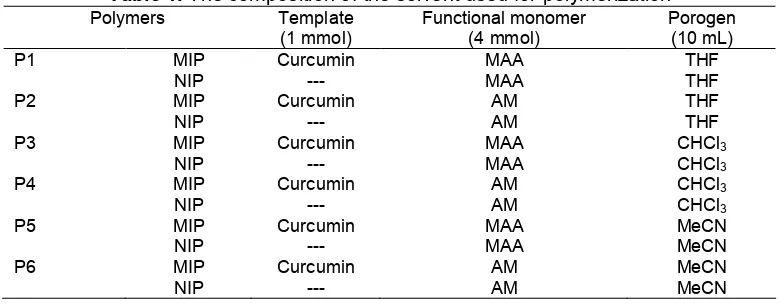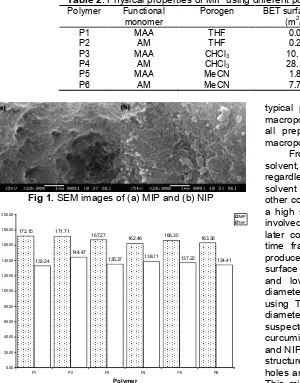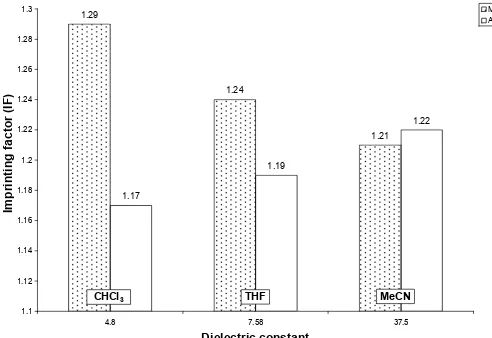POROGEN EFFECT TOWARDS THE QUALITY OF CURCUMIN
IMPRINTED POLYMER
Emi Shaqiza Azizi
1,*, Mohd Noor Ahmad
1, A.K.M. Shafiqul Islam
2,
Dahyar Arbain
2, and Iqmal Tahir
1,31
Cluster of Sensor Technology and Application, School of Material Engineering, Universiti Malaysia Perlis, no 17 Taman Pengkalan Asam, 01000 Kangar Perlis Malaysia
2
School of Bioprocess Engineering, Universiti Malaysia Perlis Jejawi, 01000 Kangar Perlis Malaysia 3
Chemistry Department, Universitas Gadjah Mada, Sekip Utara Yogyakarta Indonesia 55281
Received May 9, 2011; Accepted October 12, 2011
ABSTRACT
Molecularly imprinted polymer (MIP) is gaining importance in separation technology. In this study, curcumin has been selected as template in MIP which can be applied as sorbent materials in solid-phase extraction (SPE). Effect of porogen on the quality of curcumin-MIP is very sensitive depends on the molecular size and polarity of the porogen. We varied three solvents as the porogen i.e. tetrahydrofuran (THF), chloroform (CHCl3) and acetonitrile
(MeCN). The MIP was prepared using non-covalent approach through bulk polymerization and non-imprinted polymer (NIP) as control, also prepared using the same procedure in the absence of template. The largest imprinting factor, 1.27 was obtained from polymer P1 at ratio 1:4 of template: functional monomer. The P1 was prepared using methacrylic acid (MAA) as functional monomer and tetrahydrofuran (THF) as porogen with the highest average pore diameter i.e. 618.43 nm trough gas adsorption analysis. This will lead to better access of curcumin during batch binding analysis.
Keywords:molecularly imprinted polymer (MIP), porogen, curcumin, polarity
INTRODUCTION
Molecularly imprinted polymer (MIP) is an approach whereby a targeted compound is froze during polymerization which involves a template, functional monomer, cross linker, initiator and porogen during the process. This approach is based on shape, size and functional selectivity [1]. The principle of MIP begins with the complex formation between target compound and functional monomer (either trough covalent or non-covalent approach), polymerization with a cross linker and finally template removal to produce selective cavities [2].
The affinity and specificity of the polymers towards the template depends on the components involves during polymerization. The combination of functional monomer and porogen (solvent involves during polymerization) is one of the important factor. A suitable combination will produce good selectivity of polymer towards targeted template [3].
The interaction of functional monomer and template is based on the functional group involves in the compound. Hydrogen bonding is the common interaction involves in non-covalent approach [4]. In MIP, this interaction is easier compared to covalent interaction because the template could be removing easily during template removal procedures. With rapid technology,
functional monomer could be determined using computational modelling [5]. A possible interaction between functional monomer and template is predicted
based on the total binding energy; ΔE kcal/mol [6]. Apart from functional monomer, porogen also affected the binding affinities of MIP. Porogen is the solvent that able to form pore structures [7]. Normally, a porogen is the solvent that able to dissolve the polymerization components which is template, functional monomer, initiator and cross linking agent thus will form a uniform distribution of the cross linking in the polymer matrix. With suitable selection of porogen, good affinities of MIP towards template will obtained.
Table 1.The composition of the solvent used for polymerization
Polymers Template
(1 mmol)
Functional monomer (4 mmol)
Porogen (10 mL)
P1 MIP Curcumin MAA THF
NIP --- MAA THF
P2 MIP Curcumin AM THF
NIP --- AM THF
P3 MIP Curcumin MAA CHCl3
NIP --- MAA CHCl3
P4 MIP Curcumin AM CHCl3
NIP --- AM CHCl3
P5 MIP Curcumin MAA MeCN
NIP --- MAA MeCN
P6 MIP Curcumin AM MeCN
NIP --- AM MeCN
EXPERIMENTAL SECTION
Materials
Curcumin and ethylene glycol dimethacrylate (EDMA) were purchased from Sigma-Aldrich. Acrylamide (AM) and methacrylic acid (MAA) were purchased from R&M Chemicals (UK). 2,2’-Azobis(2-methylpropionitrile (AIBN) was obtained from Acros Organics. For methanol (MeOH), acetic acid (AcOH), chloroform (CHCl3), tetrahydrofuran (THF) and
acetonitrile (MeCN) were purchased from HmbG Chemicals. All solvents were analytical grade. Nitrogen gas was purchased from local supplier.
Instrumentation
The MIP/NIP were grinded using Planetary Ball Mill (PM 100, Retsch) and passed trough 40–25 μm mesh size sieve (PM 100, Retsch). Characterization was done using UV-Spectrophotometer (Cary50, Varian), Scanning Electron Microscope (SEM) (JEOL, JSM-6460LA) and gas adsorption analyzer (Tristar 3000, Micromeritics).
Procedure
Polymer preparation
The required amount of template, functional monomer and porogen were placed into glass tubes as listed in Table 1. All polymers were prepared using same cross linker (EDMA, 20 mmol) and initiator (AIBN, 0.16 g). For non-imprinted polymer (NIP), the procedure was similar except for the absence of curcumin. The mixtures were shaken for homogeneity and purged with N2 for 10 min to remove oxygen. Polymerization was
done under thermal condition, 60–70 °C for 24 h. Finally, the bulk polymer was crushed and sieved using sieve shaker to obtain sizes between 40–25 µm.
The soxhlet extraction procedure was carried out to remove curcumin from MIP. A combination of 10% AcOH/MeOH was used for 48 h until no curcumin detected in the final eluant. Curcumin detection was done using UV-spectrophotometer at 420 nm.
Characterization via Brauner-Emmet-Teller (BET) and Barrett−Joyner−Halenda (BJH) analysis
A defined amount of MIP and NIP (0.3 g), were degassed and removed moisture at 100 °C for a period of 4 h prior to analysis. A Tristar 3000 (Micromeritics) was utilized for BET surface area and BJH pore size distribution studies of MIP and NIP respectively.
Batch binding analysis
Batch binding analysis was conducted to evaluate properties of synthesized polymers. The polymer particles (50 mg) were placed in a screw cap test tube and mixed with 3 mL known concentration of curcumin solution. The test tube was shaken at room temperature using orbital shaker. After 24 h, the mixture was filtrated and the final concentration of curcumin in solution was checked using UV-Spectrophotometer at 420 nm. The amount of curcumin bound to polymer (Q) was calculated using Eq. (1).
V C - C
i f
Q μg g =
w (1)
where V, W, Ciand Cf represent the volume of solution
(mL), polymer weight (g), initial solution concentration (μg/mL) and final solution concentration at equilibrium (μg/mL), respectively. Imprinting factor (IF) was determined as Eq. (2).
MIP
NIP
Q IF =
Q (2)
where QMIP and QNIP are total binding amount of MIP
172.15 171.71
167.27
162.46 166.35 163.36
133.24
144.47
135.37 138.71 137.22 134.41
0.00
Table 2.Physical properties of MIP using different porogen and functional monomer Polymer Functional
monomer
Porogen BET surface area (m2/g)
Average pore diameter (nm)
P1 MAA THF 0.03 618.43
P2 AM THF 0.27 44.70
P3 MAA CHCl3 10.14 9.11
P4 AM CHCl3 28.13 6.25
P5 MAA MeCN 1.87 10.32
P6 AM MeCN 7.77 12.75
Fig 1.SEM images of (a) MIP and (b) NIP
Fig 2.Total amount of curcumin bound to polymer, Q in MeOH,initial concentration: 3 ppm, 24 h of incubation
RESULT AND DISCUSSION
Physical characterization using BET and BJH analysis
Physical characterizations of polymers were carried out using gas adsorption experiment. A BET and BJH method were applied to obtain total surface area and average pore diameter of polymers. Table 2 shows that the BET surface area is different between polymers prepared using different porogen. The MIP1 and MIP2 show the lowest surface area which is 0.02 m2/g and 0.27 m2/g. The BET surface area of MIP5 and MIP6 which were prepared using MeCN as porogen is 1.87 m2/g and 7.77 m2/g, respectively. The highest BET surface area was obtained in MIP4 i.e. 28.13 m2/g followed by MIP3 i.e. 10.14 m2/g. The MIP3 and MIP4 were prepared using CHCl3 as porogen. There are three
typical pore types in polymer which are mesopores, macropores and micropores. Apparently in this study all prepared polymer consisted of mesopores and macropores which are more than 2 nm [14].
From the results, it shows that the least polarity solvent, CHCl3 gives the highest surface area
regardless the type of functional monomer. A porogenic solvent like CHCl3 is well dissolved with template and
other components of polymers thus it is considered as a high solubility solvent. When high solubility solvent involved in polymer preparation, it tends to separate later compared to low solubility solvent. The longer time frame in separating during polymerization will produce higher surface area for polymer. A higher surface area will provide smaller pore size diameter and lower surface area will provide larger pore diameter with higher porosity. The polymer prepared using THF (P1) as porogen gives the largest pore diameter size and the lowest surface area. It is suspected that P1 will have the highest amount of curcumin bound to polymer, Q. Fig. 1 shows the MIP and NIP structures captured by SEM. It shows that MIP structures shows deeper hole compared to NIP. The holes are reflected as the selectivity sites of curcumin. This might resulted high binding amount of curcumin bound to polymer in all prepared polymers because of the pore diameter size is easily accessible during batch binding analysis. Still, the evaluation using batch binding analysis is depending on the adsorption solvent type.
Batch binding analysis for porogen selection
Good porogen selection is depending on template and functional monomer of the polymer synthesis which will give sufficient cross reactivity. Different porogen with different hydrogen bonding capacity and dielectric constant resulted vary efficiency of polymers. In this study, the polymer series were prepared using 3 types of porogen which are CHCl3, THF and MeCN.
Chloroform is a non polar solvent; THF is a moderate polar solvent whereas MeCN is a polar solvent.
1.29
CHCl3 THF MeCN
1.03
Fig 3. IF value of polymer prepared using different porogen with different dielectric constant
Fig 4.IF value of P1 – P6 in different adsorption solvent
the similar binding sites like curcumin, the value was obtained from the functional group in functional monomer that able to recognize curcumin during batch binding analysis. Nevertheless, the value is still low compared to MIP. The highest binding amount was in MIP1 i.e. 172.15 µg/g which was prepared using THF as porogen.
In comparison with the dielectric constant (Fig. 3), THF reflected as the highest IF value i.e. 1.29 followed by CHCl3 i.e. 1.23, both were prepared in MAA as
functional monomer. Commonly, non polar solvent such as CHCl3 is selected as porogen during polymerization.
Non polar solvent usually has less ability to interrupt the binding interaction occurred between template and functional monomer because of the low hydrogen bonding capacity.
In this study, it shows that THF gained more efficiency towards curcumin rebinding compared to CHCl3. A hydrogen acceptor molecule such curcumin
interacts effectively with hydrogen donor solvent THF with low dielectric constant. On the other hand, polymer
structures also depend on the type of porogen used during polymerization. Suitable porogen like THF might separate moderately during polymerization which makes the polymer highly selective and porous. A porous and sufficient binding sites will results higher binding amount, Q. This is correlated with the gas adsorption experiment. In functional monomer AM, the highest IF value was reflected in MeCN i.e. 1.24. Amide group works well in polar solvent such MeCN with stronger hydrogen bond ability. Thus it gives better efficiency compared to less polar solvent such as THF and non polar solvent, CHCl3. As shows in Fig. 3, the
IF value in AM was increased with the increasing of dielectric constant. This result suggested that IF value also related with hydrogen bonding strength.
It is concluded that P1 which was made from functional monomer, MAA and THF as the porogen gives better imprinting effect on curcumin. The result was supported with high average pore diameter size in the physical characterization experiment. To support more on this, the polymers were evaluated using different type of adsorption solvent as show in Fig. 4. It is confirmed that P1 still giving the highest IF value i.e 1.29.
CONCLUSION
The batch binding analysis results shows that P1 prepared with THF as porogen has highest IF value. This result supported with physical characterization result whereby P1 has the highest average pore diameter size. It is concluded that different porogen gives different effect on the MIP quality. The synthesized MIP will hopefully further make potential use for analytical purposes, such as selective sorbent for SPE.
REFERENCES
1. Javanbakht, M., Namjumanesh, M.H., and Akbari-adergani, B., 2009,Talanta, 80, 1, 133–138. 2. Okutucu, B., and Telefoncu, A., 2008,Talanta, 76,
5, 1153–1158.
3. Pan, H.H., Lee, W.C., Hung, C.Y., and Hwang, C.C., 2007,Electron. J. Chem., 4, 4, 611–619. 4. Caro, E., Masqué, N., Marcé, R.M., Borrull, F.,
Cormack, P.A.G., and Sherrington, D.C., 2002, J. Chromatogr. A, 963, 1-2, 169–178.
5. Karim, K., Breton, F., Rouillon, R., Piletska, E.V., Guerreiro, A., Chianella, I., and Piletsky, S.A., 2005,Adv. Drug Delivery Rev.,57, 12, 1795–1808. 6. Gholivand, M.B., Khodadadian, M., and Ahmadi,
F., 2008,Anal. Chim. Acta., 658, 2, 225–232. 7. Sellergren, B., and Hall, A.J., 2001, Fundamental
imprinted network polymers, inMolecularly Imprinted Polymers: Man-Made Mimics of Antibodies and Their Applications in Analytical Chemistry, B. Sellergren, Editor. Elseveir, Amsterdam.
8. Bharat, B.A., Young-Joon, S., and Shishir, S., 2007, The Molecular Target and Therapeutics Uses of Curcumin in Health and Disease, Antioxidant and Anti-inflammatory Properties of Curcumin, Springer 2007.
9. Motterlini, R., Foresti, R., Bassi, R., and Green, C.J., 2000,Free Radical Biol. Med.,28, 8, 1303–1312. 10. Yu, H., and Huang, Q., 2009, Food Chem.,119, 2,
669–674.
11. Basile, V., Ferrari, E., Lazzari, S., Belluti, S., Pignedoli, F., and Imbriano, C., 2009, Biochem. Pharmacol.,78, 10, 1305–1315.
12. Manikandan, P., Sumitra, M., Vinaya, S.G., and Lonchin, S., 2006, Mol. Cell. Biochem., 290, 1-2, 87–96.
13. Gopinath, D., Ahmed, M.R., Gomathi, K., Chitra, K., Sehgal, P.K., and Jayakumar, R., 2004, Biomaterials, 25, 10, 1911–1917.


